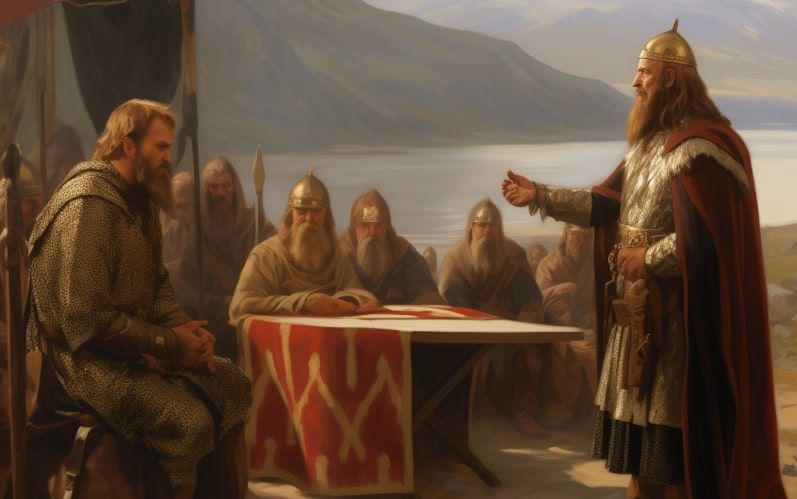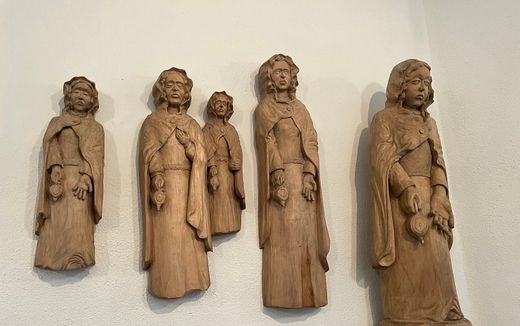A 1,000 years ago, King Olav started to end slavery in Norway

King Olav’s first steps in Norway. Photo Drommenomnorge.no
Northern Europe
King Olav II walked along the shores of this small Norwegian island. He knew that he was about to change the nation forever. The king was heading to adopt the famous Kristenretten, the Christian Law. The year 2024 marks the 1000th anniversary of this momentous event that became the end of slavery.
The island where the king walked was Moster. It lies near the Norwegian coastline, not far from Haugesund on the western coast. Today, a beautiful village of wooden houses named Mosterhamn stands as the best witness to the adoption of the Kristenretten.
The small white stone church stands at a walking distance from the harbour. It was built on the site of a previous wooden chapel in 1150. The church is one of the oldest standing in the country. It was in this very place that the new Christian Law code was adopted.
Destruction
A few decades earlier, King Olav I had already landed here. He had come to faith in Christ during his years of Viking expedition in England. When he was still a boy, Olav travelled to England and began to cause great destruction there. Quite amazingly, Olav I met a monk from the Scilly Isles and converted to Christianity during those years. Soon after, in 994, Olav had his baptism in Andover, England.
Olav returned to Norway in 995 with the intention to ascend to the throne and Christianise his country. His very first act in Mosterhamn was to order a moment of thanksgiving in a tent on the spot where the church stands today. Olav's vision was clear: The worship of God ought to be the foundation of Norwegian society.
Olav felt the calling to rule the Norwegian people. He set sail towards the North to fight against the ruler of Norway, Håkon Jarl, near present-day Trondheim. Håkon Jarl had, like many other kings before him, eliminated his rivals to the throne. Moreover, at a time when Christianity was on the rise, he also wanted to re-paganise his country. So, Olav was a double threat to his rule. He succeeded, and so became the first Christian king of the nation. During the five years of his reign, Olav I evangelised with pressure; people had little choice but to get baptised.
Foreign expeditions
A few decades after Olav I, King Olav II came, who had his distant relative Olav as his godfather. He was very well aware of what his predecessor had done in Moster. He, too, had come to faith in Christ during his foreign expeditions and was now willing to continue the Christianisation of his country. Mosterhamn was thus a perfect place to adopt the Christian Law.
Kristenretten was certainly not Norway's first law code. However, the difference was that it aimed to define crime and punishment according to Biblical standards.
So, how did Kristenretten redefine the law code of Norway?
Firstly, if crime had to be defined according to God's standards, Kristenretten had to be aligned with the Ten Commandments. To start, how did it interpret the First Commandment, Thou shalt have no other gods before me? Kristenretten boldly prohibited heathen gods and customs.
Political assembly
No doubt, the first commandment led to huge social change. Kristenretten was the first step toward the abolition of slavery. In previous times, the nation was used to human sacrifices (usually slaves) before a political assembly (named "ting" or" thing") took place in the land. Of course, Kristenretten prohibited such practices. It even ordered slaves to be liberated before each political assembly or on festive days such as Christmas.
The law code also dealt with the church and worship. It included laws about church buildings, the rights and duties of church officials, the observance of holy days and days of fasting, baptisms and burials. The law also instituted Christian marriage and promoted the raising of children in the faith, which both served to build Christian families and society.
It would be a mistake to suggest that Kristenretten followed Biblical principles on every point. True, the understanding of crime came much closer to Biblical standards than the earlier law codes. But sometimes, the punishments were still inspired by ancient pagan practices. For example, sexual relationships outside of wedlock were prohibited. Yet infants born outside of marriage were killed unless the woman had been a victim of rape. The Biblical law code indeed institutes the death penalty for the adulterer but not for the illegitimate child.
In spite of such a practice, Kristenretten was nonetheless a decisive improvement when compared to previous pagan law codes. After the Reformation, the law codes of the Lutheran countries, such as Norway, became even more aligned with the Bible, in particular following the work of the German lawyer Johann von Schwarzenberg (1463-1528) in the German lands.
1024 was truly a turning point in Norwegian history. Each law code that was adopted in the following centuries followed the foundations laid by the Kristenretten.
This year, Norway celebrates the change with several activities, varying from an international conference to an evangelisation campaign.
Related Articles










